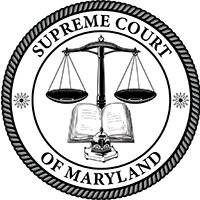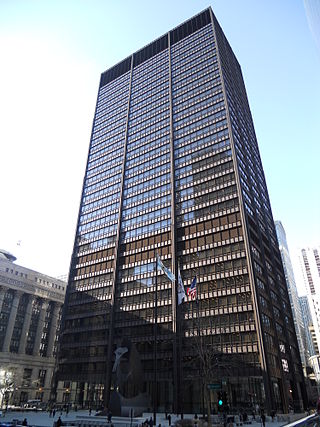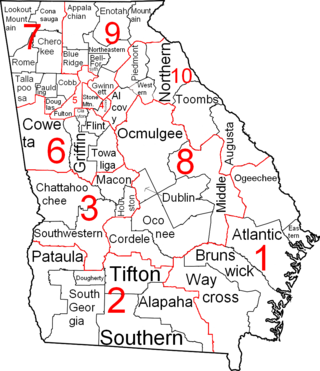Circuits
There are 25 judicial circuits in the state, each comprising one or more of Illinois' 102 counties. The jurisdiction of seven of these circuits courts are solely within the confines of a single county; these are Cook, Kane, Will, DuPage, Lake, McHenry (all Chicago metropolitan area counties), and St. Clair in Metro East. The other 18 circuits each contain between two and 12 counties.
Circuit Court of Cook County
The Circuit Court of Cook County is not a numbered circuit. The Judicial Circuits Districting Act of 2022 increased the number of subcircuits from 15 to 20 subcircuits starting December 2, 2024.
Second Circuit
The Second Circuit consists of the counties of Hardin, Gallatin, White, Hamilton, Franklin, Wabash, Edwards, Wayne, Jefferson, Richland, Lawrence, and Crawford. [3]
Third Circuit
The Third Circuit consists of the counties of Madison and Bond. [3] Under the Judicial Circuits Districting Act of 2022, the third circuit is to receive four subcircuits (three in Madison County, one in Bond County).
Fourth Circuit
The Fourth Circuit consists of the counties of Clinton, Marion, Clay, Fayette, Effingham, Jasper, Montgomery, Shelby, and Christian. [3]
Fifth Circuit
The Fifth Circuit consists of the counties of Vermilion, Edgar, Clark, Cumberland, and Coles. [3]
Sixth Circuit
The Sixth Circuit consists of the counties of Champaign, Douglas, Moultrie, Macon, DeWitt, and Piatt. [3]
Seventh Circuit
The Seventh Circuit consists of the counties of Sangamon, Macoupin, Morgan, Scott, Greene, and Jersey. [3] Under the Judicial Circuits Districting Act of 2022, the seventh circuit is to receive seven subcircuits (two in Sangamon County, one in each of the remaining counties).
Eighth Circuit
The Eighth Circuit consists of the counties of Adams, Schuyler, Mason, Cass, Brown, Pike, Calhoun, and Menard. [3]
Ninth Circuit
The Ninth Circuit consists of the counties of Knox, Warren, Henderson, Hancock, McDonough, and Fulton. [3]
Tenth Circuit
The Tenth Circuit consists of the counties of Peoria, Marshall, Putnam, Stark, and Tazewell. [3]
Eleventh Circuit
The Eleventh Circuit consists of the counties of McLean, Livingston, Logan, Ford, and Woodford. [3]
Twelfth Circuit
The Twelfth Circuit consists of Will County. [3] Under the Judicial Circuits Districting Act of 2022, the twelfth circuit is to receive five subcircuits.
Thirteenth Circuit
The Thirteenth Circuit consists of the counties of Bureau, LaSalle, and Grundy. [3]
Fourteenth Circuit
The Fourteenth Circuit consists of the counties of Rock Island, Mercer, Whiteside, and Henry. [3]
Fifteenth Circuit
The Fifteenth Circuit consists of the counties of Jo Daviess, Stephenson, Carroll, Ogle, and Lee. [3]
Seventeenth Circuit
The Seventeenth Circuit consists of the counties of Winnebago and Boone. [3] The number of subcircuits will decrease from four to two effective December 2, 2024.
Eighteenth Circuit
The Eighteenth Circuit consists of DuPage County. [3] The circuit is further divided into seven subcircuits.
Nineteenth Circuit
The Nineteenth Circuit consists of Lake County. [3] Under the Judicial Circuits Districting Act of 2022, the number of subcircuits in the Nineteenth Circuit is to increase from 6 to 12 subcircuits.
Twentieth Circuit
As of December 5, 2022, the twentieth circuit consists solely of St. Clair County. Prior to December 5, 2022, it had also included the counties of Randolph, Monroe, Washington, and Perry. [3]
Twenty-first Circuit
The Twenty-first Circuit consists of the counties of Iroquois and Kankakee. [3]
Twenty-second Circuit
The Twenty-second Circuit consists of McHenry County. [3] The circuit was created when McHenry County was separated from the Nineteenth Circuit into its own circuit and is divided into four subcircuits. It came into effect December 4, 2006. [4]
Twenty-third Circuit
The Twenty-third Circuit consists of the counties of DeKalb and Kendall. [3] The circuit was created after DeKalb County and Kendall County were split from the Sixteenth Circuit by Public Act 97-0585. The circuit came into effect on December 3, 2012. [4]
Twenty-fourth Circuit
The twenty-fourth circuit came into effect on December 5, 2022. It consists of the counties of Randolph, Monroe, Washington, and Perry. [3]









